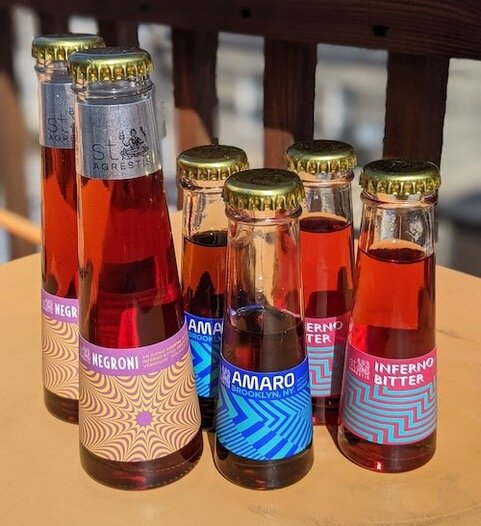How St. Agrestis Is Bringing Better Bitters to Brooklyn
Like most things Italian, the country’s apertivi and digestivi are steeped in tradition. Each region, each town, each family--everyone has opinions on which herbs, spices, and fruits belong in the recipe. In the new world, producers have a choice; should they attempt to mimic the classic old-world flavors of bottles like Campari, Aperol, Fernet Branca? Or dare they try to improve them?
At St. Agrestis in Green Point, Brooklyn, Louis Catizone has passionately chosen the latter.
Louis Catizone
Catizone had been working on a red bitter formula for years when he bought St. Agrestis (and their recipe for amaro, which he also tinkered with) in 2017. He co-owns and operates the company with his brother, Matt, and brothers Phillip and Steven DeAngelo from neighboring Greenhook Ginsmiths. His “lightbulb moment” occurred when he cracked a 40-year-old bottle of Campari from the basement of his Aunt’s shuttered restaurant in Bolzano. “The herbal complexity and freshness was mind-blowing and became the inspiration for our bitter. [The Inferno bitter is] a tribute to Campari—I’ve drunk a lot of it—and that guided the direction of our flavor profile.” Catizone worked to combine that “bracing, bittersweet flavor profile” with nuanced, floral elements, and far less sweetness. “We use organic cane sugar we import from South America, and that helps the balance.”
His St. Agrestis amaro, meanwhile, reads baking-spicier than most, with a distinct yet typical cola nose and a warming allspice flavor that works beautifully neat as a digestivo, and adds a deep essence to cocktails—try it stirred into your next dark rum or rye drink.
Amaro and Aperitivo
The amaro and aperitivo are each built from individual botanic macerations—twenty different kinds in the amaro, seventeen for the Inferno—as, according to Catizone, each type of spice, flower, and citrus “needs a different percentage of alcohol and time to get those extractions. This process allows those flavors to shine without becoming bitter. We then blend those macerations, which adds complexity, elegance, nuance, and then we age them together,” the amaro in spent bourbon barrels for sixteen weeks, the bitter in stainless steel for twelve.
In May 2018, St. Agrestis introduced their bottled Negroni, a mix of Greenhook Ginsmith’s Gin, house-made Torino-style vermouth, and Catizone’s yet-to-be-released Inferno Aperitivo. According to Catizone, the ready-to-drink (RTD) cocktail “allowed [home] customers to try the aperitivo in a more familiar format, and to communicate that Inferno was built for the negroni.” St. Agrestis also got to show of their adorable conical glass pop-top bottles, at once contemporary and traditional. Their mini, 50 ml. versions instantly became the perfect way to tote shots of amaro and aperitivo pretty much anywhere.
When the Inferno made its solo debut in May 2019, the new red-bitter-on-the-block was quickly adopted as a prized cocktail ingredient by beverage folks at high-end bars and restaurants nationally. The next step in Catizone’s quest for “cocktails as new world applications for old-world ingredients” came in a can—the delightful St. Agrestis Spritz. Bottled in 2018 and canned in 2019, the little refreshers contain Catizone’s unreleased Paradiso apertivo and white wine from the Veneto (the grape is glera, traditionally used in Prosecco), carbonated together. The Paradiso formula, designed for splashing in a spritz, was originally slated for individual release in 2020 but delayed by the pandemic. This apertivo formula, more citrus-driven and herbal than most, helps Catizone nail a less syrupy, drier, and more fresh flavored product than most RTD fizzies on the market.
Bag-in-a-box Negroni
Already known for these passionately prepared versions of the old-world style classics, St. Agrestis made big waves when they introduced their innovative bag-in-box negroni in July 2020. Like draft cocktails in bars, home mixologists can now serve the St. Agrestis negroni on demand—from a delicious, convenient, and economical 1.75-liter format. Batched in the same recipe as the bottled version, these negronis are as they should be--boozy (24% alcohol) and not too sweet, and because they don’t oxidize, can be stored for at least three months. At $59.99 for 20 cocktails, drinkers get the best $3.00 cocktail around--just add a swath of orange peel and maybe an ice cube.



